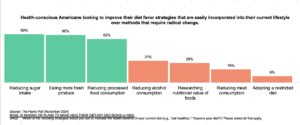Brief • 3 min Read

Eating better: it’s the goal that appears on most New Year’s Resolution lists year after year (63% of U.S. adults according to a recent Harris Poll study).
For many, eating healthier wasn’t just a resolution. Heading into 2025, half (51%) of U.S. adults decided to take the leap and choose to make healthier dietary decisions.
That said, it’s easy to set a goal, but working toward it for an extended period proves to be much harder. The phenomenon of dropping a New Year’s Resolution is so ingrained in our culture that we have an unofficial holiday memorializing the abandoned habits we pledged ourselves to at the start of the year. Since making healthy changes to one’s diet being a perennially popular resolution, it’s also a very popular goal to drop.
Making even a small change to a regular diet is easier said than done. Saying goodbye to a comfort meal, learning new recipes, and resisting the late -night temptations of an open drive-thru can be significant hurdles to overcome.
But the challenges of improving one’s diet begin much earlier than fast food withdrawals. The world of health-conscious food can be a confusing place, and newcomers looking to improve their diet could be bombarded with dubious fad diets, misleading food labels, and unregulated food certifications implying health benefits.
So, what strategies are the 51% of U.S. adults looking to improve their diet using to eat healthier, and what do those strategies say about how we want to improve our health?
Below are the most and least frequently cited strategies among U.S. adults currently looking to improve their diet.

While these findings seem straightforward (and a little uninteresting) on the surface, both the CDC and Harvard Medical School support the most popular strategies as solid options to improve one’s health. However, looking at how the most popular dieting strategies compare to the least popular starts to tell a more nuanced story about U.S. adults’ journey to healthier eating.
Research shows that these unpopular, “break in case of emergency,” lifestyle changes have the potential to radically improve the health of those who adopt them. The National Institute of Health found that adopting a restrictive diet helps lower risks associated with obesity, extend one’s life span, and even suppress some cancers.
Reducing meat consumption is associated with a lower risk of heart disease, kidney disease, and type 2 diabetes, while simultaneously lowering levels of cholesterol and boosting immune system function. Not to mention, buying protein-rich, plant-based foods like beans and tofu is more wallet friendly than purchasing a ribeye steak.
According to Dr. Katie Witkiewitz (Director of the University of New Mexico’s Center on Alcohol, Substance Use, and Addictions), “… [alcohol is] harmful for pretty much every organ system.” It’s not surprising then that drinking less alcohol can improve sleep, raise energy levels, and lower risks of cancer. Finally, researching the nutritional value of foods allows consumers to make informed dietary choices.
It’s clear that effectiveness isn’t the difference between the most and least popular strategies to improve one’s diet. If not efficacy, what separates popular dieting strategies from unpopular ones?
The most striking difference between the most and least adopted strategies is the level of change one needs to make to their lifestyle to adopt and maintain the healthy habits. Flexibility is built into each of the most popular dieting strategies. One can reduce their sugar intake by 50% or 5% and still feel like they are achieving their health goals. The least popular, by contrast, require more radical lifestyle changes to adopt.
Choosing a radical lifestyle change as the cornerstone of one’s health journey has pros and cons. They can make it easier to set and achieve concrete goals, fundamentally change harmful habits, and maintain accountability. More strenuous healthy eating strategies can also cause stress and feelings of failure, potentially discouraging some from maintaining a healthy diet after a setback.
Trends found in the most and least popular dieting strategies among health-conscious U.S. adults is emblematic of broader attitudes towards healthy living. Most would trade maximum efficacy for achievable, adaptable, and repeatable strategies to improve their quality of life.
Weight loss is a meaningful indicator of progress for many (51%) who decide to make dietary changes. GLP-1 drugs (marketed under brand names like Ozempic and Wegovy) promises those working to improve their diets that they could have their cake and eat it too. However, this seemingly miraculous weight loss hack could be a hurdle to developing healthy habits if relied on too heavily.
Originally developed as a diabetes medication, the appeal of GLP-1 drugs is obvious. Through only one dose a week, users can lose life-changing amounts of weight seemingly overnight.
That said, the incredible weight loss stories associated with the drug can overshadow intense side effects. GLP-1 injections can cause intense nausea, vomiting, diarrhea, and stomach pain. Overdosing GLP-1 is surprisingly easy, since injections are self-administered, and not every brand offers pre-packaged dosing. Overdoses greatly intensify adverse side effects.
Clinical trials for GLP-1 medications throw cold water on their reputation as a weight-loss magic-bullet. They find that while GLP-1 users lost an average of 17.3% of their body weight while on the drug, they also gained back 11.6% of their original body weight after stopping the drug.
Outside of clinical discussions about GLP-1, our research shows that most Americans looking to improve their eating habits gravitate towards flexible lifestyle changes that are easy to maintain. Despite some GLP-1 providers’ messaging, adopting a weight loss plan centered around the medication will almost certainly involve discomfort and radical change.
In the coming years, the health and wellness industry will likely see pushback on valuing quick results over building deliberate healthy habits. Most Americans currently say they want healthier daily routines, while the loudest voices in health and wellness culture promote intense plans that trade discomfort for dramatic results. Instead, those in the health and wellness space should focus on promoting grounded plans to an audience that currently craves goals within their reach.
Analyzing the most and least popular strategies for eating better shows that there is value in promoting goals that are achievable to the majority of those looking to improve their life. At the end of the day, all any of us can do to improve our health is to make the best decisions we can within the boundaries that our lives allow. By deciding to make a healthy change, no matter how small, we are setting ourselves on a path to a healthier life.
This survey was conducted online in the United States by The Harris Poll from November 22nd, 2024 to November 25th, 2024 among 1,071 U.S. adults, aged 18+. Figures for age, sex, race and ethnicity, education, region, household income, and propensity to be online have been weighted where necessary to bring them into line with their actual proportions within the US population. Respondents for this survey were selected from a pool of potential respondents who have agreed to participate in The Harris Poll’s online research.
Subscribe for more Insights
Subscribe to our newsletter for the latest trends in business, politics, culture, and more.
Related Content









